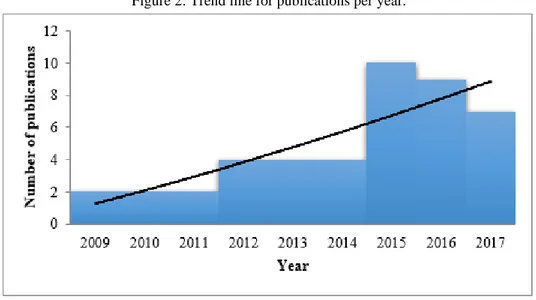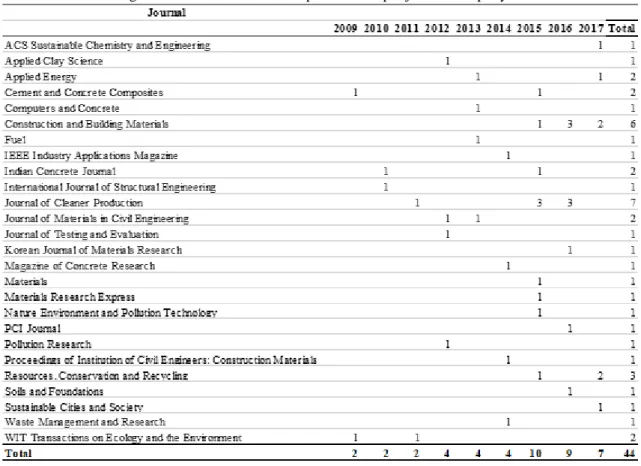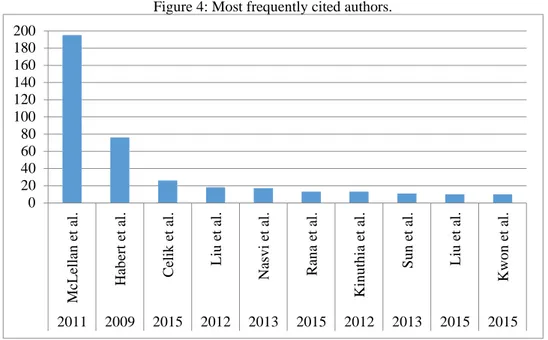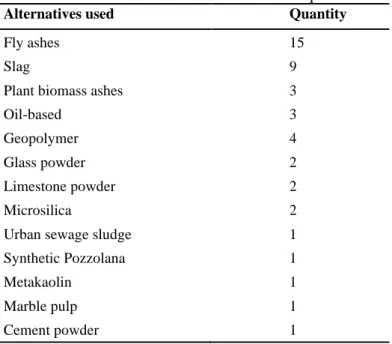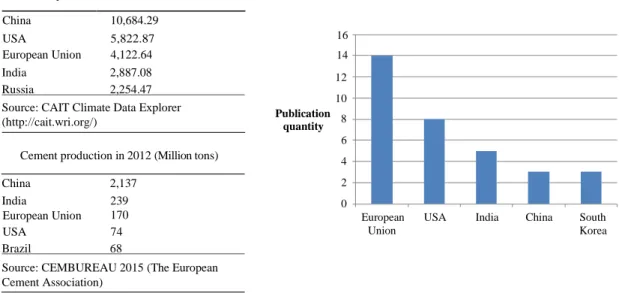Bibliometric analysis on sustainability in the cement industry
Análise bibliométrica de sustentabilidade na indústria do cimento
DOI:10.34117/bjdv6n10-607
Recebimento dos originais:08/09/2020 Aceitação para publicação:27/10/2020
Julia Santiago de Matos Monteiro Lira Mestra em Construção Civil Instituto Federal do Piauí – IFPI
Rua Urquiza Machado, 462 Floriano- Piauí (Brasil) E-mail;juliasanttiago@gmail.com
Laís Bandeira Barros Mestra em Construção Civil
Ghent University
Tweekerkenstraat 2, 9000 Gent (Bélgica) E-mail;laisbandeirab@gmail.com
Luiza Rodrigues Meira de Miranda Mestra em Construção Civil
Ghent University
Technologiepark 60, 9052 Zwijnaarde (Bélgica) E-mail;luiza.miranda@ugent.be
ABSTRACT
The calcination of calcium carbonate, the clinkerization process and the burning of fossil fuels when manufacturing cement are the main culprits of the high CO2 emissions by the cement sector. CO2 is
known for being the main greenhouse gas (GHG) and there are growing concerns both nationally and internationally about reducing its emissions. Research on technologies aimed at reducing GHG emissions during the cement manufacturing process can be found in the scientific literature, and include mineral addition, clinker-free cement (or with low clinker content), kiln efficiency, carbon capture, use of raw materials and alternative fuels, among others. The aim of this research was to present a bibliometric analysis of studies on alternatives to reduce greenhouse gas emissions and substitute the use of clinker or cement internationally. The research was based on scientific papers published in renowned journals from 2007 to 2017. Keywords related to CO2 emissions from clinker
and cement production were searched for within the vast sustainability area in the Scopus database. The search comprised data on the type of solutions adopted for reducing emissions, the country where the study was conducted, and the number of publications per year and per journal. With the results of this research in hand, the amount of publications from each country was matched with their GHG emission levels. According to the authors, the sustainability of the cement sector depends on reducing kiln energy consumption and clinker consumption in cement, or using less cement in concrete. Moreover, the most widely analyzed impact categories were energy consumption and CO2
emissions, despite the likelihood of other categories having even greater impacts.
RESUMO
A calcinação do carbonato de cálcio, o processo de clínquerização e a queima de combustíveis fósseis no fabrico de cimento são os principais culpados das elevadas emissões de CO2 pelo sector cimenteiro. O CO2 é conhecido por ser o principal gás com efeito de estufa (GHG) e existem preocupações crescentes, tanto a nível nacional como internacional, sobre a redução das suas emissões. A investigação sobre tecnologias destinadas a reduzir as emissões de GEE durante o processo de fabrico do cimento pode ser encontrada na literatura científica, e inclui adição mineral, cimento sem clínquer (ou com baixo teor de clínquer), eficiência do forno, captura de carbono, utilização de matérias-primas e combustíveis alternativos, entre outros. O objectivo desta investigação foi apresentar uma análise bibliométrica de estudos sobre alternativas para reduzir as emissões de gases com efeito de estufa e substituir a utilização de clínquer ou cimento a nível internacional. A investigação foi baseada em artigos científicos publicados em revistas de renome de 2007 a 2017. Foram pesquisadas palavras-chave relacionadas com as emissões de CO2 da produção de clínquer e cimento dentro da vasta área da sustentabilidade na base de dados Scopus. A pesquisa incluiu dados sobre o tipo de soluções adoptadas para reduzir as emissões, o país onde o estudo foi realizado, e o número de publicações por ano e por revista. Com os resultados desta pesquisa em mãos, a quantidade de publicações de cada país foi comparada com os seus níveis de emissão de GEE. Segundo os autores, a sustentabilidade do sector cimenteiro depende da redução do consumo de energia do forno e do consumo de clínquer no cimento, ou da utilização de menos cimento no betão. Além disso, as categorias de impacto mais analisadas foram o consumo de energia e as emissões de CO2, apesar da probabilidade de outras categorias terem impactos ainda maiores.
Palavras-chave: cimento, GHG, sustentabilidade, análise bibliométrica.
1 INTRODUCTION
Cement is the most widely consumed artificial material (AGOPYAN; JOHN, 2011; SCRIVENER, JOHN and GARTNER, 2016). According to Scrivener; Kirkpatrick (2008), every year more than 1 m³ of concrete is produced per person in the world. Its manufacturing process revolves around the production of clinker, when particulate materials and harmful gases are released into the atmosphere. In recent years, as concerns grow over global warming (as a result of the high concentration of greenhouse gases - GHG), the cement industry became a key player in the promotion of significant reductions in emissions through alternatives such as: addition of by- products to cement, use of alternative burning fuels, carbon filters and credits.
For Scrivener; Kirkpatrick (2008), the rising pressure for innovation in order to promote sustainability comes from the fact that cement production alone accounts for 5-8% of CO2 emissions
by man. Therefore, the cement industry is currently committed to reducing emissions and other environmental impacts that arise from the cement manufacturing process (ISHAK; HASHIM, 2015).
For Assi et al. (2016), finding alternatives to Portland cement is of paramount importance due to the high carbon dioxide emissions associated with its manufacturing process. These CO2
emissions result partly from the fossil fuel combustion and partly from the limestone calcination process (HOSSAIN et al., 2017; ALI et al., 2011). These are considered the main GHG sources in clinker production (LIU et al., 2015), and make the cement industry one of the main contributors to greenhouse gas emissions, specially CO2 emissions, according to Ali et al. (2011).
Different studies have discussed the use of alternative materials instead of clinker or of other alternatives to reduce the amount of cement in concrete. For example, Moraes et al. (2017) used blast furnace slag combined with sugarcane straw ashes as an alternative to the use of Portland cement. The mixture was combined with an alkaline solution (sodium hydroxide and sodium silicate) to obtain an alkali-activated material. The authors considered the use of residues a sustainable practice and based on that they assessed the similarity of mechanical properties, concluding that the alkaline solution played a role in the development of compressive strength. The samples reached more than 60MPa after 90 days of curing and the ashes could replace the sodium silicate, a pollutant and expensive chemical agent, thus producing a sustainable binder.
Hossain et al. (2017) used the life-cycle assessment (LCA) technique to quantify the energy consumption and potential global warming of different manufactured cements. They proposed two alternatives: the use of glass powder from locally found glass bottles as one of the raw materials, and the use of biofuels such as locally generated wood residues and coal. The LCA results demonstrated that the common method for producing Portland cement cause great environmental impact, mainly due to the importation of raw materials associated with the burning of fossil fuels. Therefore, with the proposed alternatives, there was a 15% reduction in energy consumption and a 12% reduction in GHG emissions.
Omran et al. (2016) used supplementary cementitious materials, namely glass powder, to partially replace cement, thus reducing cement production, and consequently fossil fuel consumption and GHG emissions. The authors concluded that the mechanical characteristics required were met and improved.
This research, especially from an academic point of view, is a starting point for applications in the productive sector. It is also necessary to conduct a timely study to quantitatively assess the fast-growing body of literature on alternatives to reduce GHG emissions in the cement industry, with the help of bibliometric techniques (GENG et al., 2017).
According to Geng et al. (2017), a bibliometric analysis consists of a well-established research method, particularly in information science, to assess the performance of academic research
studies. Quantitative analyses and statistical methods are adopted to analyze how content information relates in a certain field. The research field's characteristics and standards are also analyzed.
The aim of this study is to find the knowledge gap based on careful research analysis within the international literature with respect to alternatives that can reduce greenhouse gases and replace clinker or cement. The absence of similar studies underscores the justification for carrying out this study.
2 CEMENT SUSTAINABILITY
The importance of sustainability goes beyond environmental issues. Sustainable development comprises social, environmental and financial factors and appropriate governance mechanisms to help keep the balance between competing objectives (DEB; WELLING, 2010). The global initiatives of the cement industry to reduce emissions demonstrate how relevant this topic is. The Cement Sustainable Initiative (CSI) is a global effort by major cement producers with operations in more than 100 countries who believe there is a strong business case for the pursuit of sustainable development (www.wbcsdcement.org). Collectively these companies account for around 30% of the world's cement production and range in size from very large multinationals to smaller local producers. In 2005, the CSI published its first emissions measurement and reporting guidelines to provide a common framework to its members and to the wider industry. CSI member companies subsequently started reporting annually on a set of agreed key performance indicators for emissions and set their own emissions reduction targets.
Scrivener, John and Gartner (2016) produced a document through the United Nations Environment Programme (UNEP). The UNEP-SBCI established a working group involving academics and the industry with the objective of revising alternative technologies specifically for the manufacturing and use of cement, and capable of reducing CO2 emissions and increasing the
efficiency of materials throughout the cement value chain. The group limited its approach to solutions concerning the materials, since aspects such as renewable fuel and energy had already been analyzed. According to this document, there are two major factors that effectively play a substantial role in reducing global CO2 emissions related to cement and concrete production. These
factors are the growing use of supplementary cementitious materials (SCMs) to partially replace clinker in cement, and the more efficient use of clinker in concrete, combined with other alternative materials.
SEARCH GROUPING READING
STATISTICAL AND QUANTITATIVE
ANALYSIS
NOTE-TAKING EXCLUSION
Based on all of the aforementioned documents, the main focus of this research was the reduction in clinker emissions during cement manufacturing and the reduced cement content in concrete. Combustion issues were left out of this research.
3 MATERIAL AND METHODS
Since this is an exploratory study, the research methodology was restricted to the following keywords: "clinker" or "cement" and "CO2" or "emissions" or "GWP" and "sustainable" or
"sustainability". This choice was based on an extensive search through the Scopus scientific database, which offers a more flexible overview of the world research production in the science field (YATAGANBABA and KURTBAŞ, 2016).
The research was limited as described below: • Time period: 2007 the 2017;
• Database: Scopus;
• Type of publications: papers from journals.
After searching for the keywords, the methodological steps were divided according to Figure 1.
Figure 1: Methodological steps.
The keywords mentioned above were searched for and grouped by name and origin of authors, title of paper, journal name, year, abstract and author keywords. Reading was a necessary step to extract data for note-taking purposes. The papers which fell outside the scope were then set aside. Only the papers which addressed alternative replacements for clinker or cement were considered. Among the papers considered, literature reviews focusing on fossil fuel combustion were not analyzed. Once the notetaking was concluded, a quantitative analysis was carried out.
The analysis was conducted by relating the amount of publications per year and the mentioning of keywords per group, and the publications per country and author affiliations.
To measure the influence and examine the publication characteristics, the keywords were separated into groups. Based on the context, the groups chosen were as follows:
• Cement: when there was an approach to reduction through the replacement of clinker in cement;
• Concrete: when there was an approach to reduction through the replacement of cement in concrete;
• Supplemental cementitious materials: which include alternative materials such as fly ashes and blast furnace slag;
• Properties/performance: which addresses mechanical properties or performance characteristics;
• Sustainability assessment methodology: includes methods for quantifying the environmental impact.
• CO2 Emissions: impact category used by authors;
• Sustainability.
With the note-taking, it was possible to note which alternatives were used to reduce environmental impact, and also how the sustainability factor was measured.
Finally, the results per country were correlated with the amount of GHG emissions and the amount of cement produced per year. The objective was to measure the level of concern of different countries based on their global contribution, both regarding emissions, as well as cement manufacturing.
4 RESULTS AND DISCUSSION
Upon reading, the papers that fell out of the scope and which did not meet the objectives proposed, along with those which addressed emissions reduction focusing on fuel replacement in cement plants, and those which reviewed the literature or gave an overview of the last few years in the cement industry were left out of this research. The total analyzed in each one of the articles is presented in table 1.
Table 1: Papers found and papers excluded.
Papers excluded
Base Papers
identified Papers out of
the scope Papers centered around combustion Review articles Papers analyzed Scopus; 96 41 4 7 44
With the exclusion of papers that did not fit the proposed objectives, the first goal was to identify the trend line for the annual production (Figure 2).
Figure 2: Trend line for publications per year.
A second-order polynomial trendline was chosen in order to maximize the progression and views of the publications and to minimize errors. There was a considerable increase until the year 2015, coinciding with environmental concerns by the public and academic sectors, which led to the Paris Agreement1 in 2015. Despite this, from this year onwards, there was a decrease in the number of publications. As the trend line is still ascending, academics tend to keep going in this same direction towards research on sustainability in the cement sector.
The correlation matrix of the number of publications per journal every year was developed and presented in Figure 3.
1The Paris Agreement gathered 195 countries to propose measures for the reduction in greenhouse gas (GHG) emissions
Figure 3: Correlation matrix of publications per journal and per year.
As the number of publications on the topic increased, the effects were also felt in journals like the Journal of Cleaner Production and Construction and Building Materials, which also had an increase after 2015. These two journals accounted for 12 publications out of a total of 40, while other journals had a maximum of 2 papers within the same period. The Journal of Cleaner Production has an impact factor of 5.715, while the Construction and Building Materials has an IF of 3.169, demonstrating that this is a high-profile topic worldwide.
The most frequently cited authors (per year) are presented in Figure 4. There is a great disparity in the number of citations. The most cited article is by McLellan et al. (2011) and is called "Costs and carbon emissions for geopolymer pastes in comparison to ordinary Portland cement" (Australian author and Japanese coauthor). Curiously, it is the only paper on the topic in the Journal of Cleaner Production published before 2015.
Figure 4: Most frequently cited authors.
When it comes to keywords, the grouping resulted in the radar chart presented in Figure 5.
Figure 5: Number of keywords per group.
It can be noted that the 'supplementary cementitious materials' group was more cited by the authors than the group of cement or concrete itself. This demonstrates the authors' attention to the chosen alternatives for reducing clinker in cement and cement in concrete by using materials that have cementing properties. The sustainability assessment methodology, that is, the methods chosen
200 180 160 140 120 100 80 60 40 20 0 2011 2009 2015 2012 2013 2015 2012 2013 2015 2015 70 60 50 40 30 20 10 0 C em en t Mc L ellan et al. C o n cr ete Hab er t e t a l. C elik et al. Su p p lem en tar y C em en titi o u s Ma ter ials L iu et al. Nasv i e t a l. Pro p er ties / Per fo rm an ce R an a et al. Kin u th ia et al. Su stain ab ilit y Su n et al. Su stain ab ilit y ass es sm en t m eth o d o lo g y L iu et al. Kwo n et al. E m is sio n s
by the authors to quantify the environmental impacts generated, was barely mentioned, differently from the 'properties/performance' group. As expected, sustainability was mentioned several times, together with the emission category, mostly related to the amount of greenhouse gases (GHG).
Once the articles were read, the chosen alternatives (presented in Table 1) within the supplementary cementitious materials group were separated. As it can be noted, fly ashes and blast furnace slag are the most lead the rank of alternatives. Possibly, because these are residues with well-known characteristics. Even so, the presence of innovative materials (or residues) demonstrates that there is room for further research.
Table 1: Alternatives used for clinker or cement replacement.
Alternatives used Quantity
Fly ashes 15
Slag 9
Plant biomass ashes 3
Oil-based 3
Geopolymer 4
Glass powder 2
Limestone powder 2
Microsilica 2
Urban sewage sludge 1 Synthetic Pozzolana 1
Metakaolin 1
Marble pulp 1
Cement powder 1
There are some methodologies to quantify environmental impacts, such as: on-site measurement through case studies; and the Life Cycle Assessment (LCA) technique, which compiles certain environmental impacts through the quantification of all inputs and outputs from products and processes.
Of the 40 papers analyzed, only 11 used one of these methodologies. Other authors just assumed that the use of residues already demonstrates a sustainable attitude. Therefore, they preferred to focus on technical feasibility aspects based on essays to determine the mechanical properties and/or performance characteristics of the materials.
The involvement of a certain country in the scientific literature is, or should be, closely related to its economic, social and environmental situation. Figure 6 contains information showing
the five countries with the highest GHG emission rates2 in the year 2012, the five greatest cement producers in the world, and a graph with the amount of publications on cement sustainability (as analyzed in this research).
Figure 6: List of countries with most publications/ greatest cement producers/ top GHG emitters.
CO2-eq emissions (Million tons) in 2012
China 10,684.29
USA 5,822.87 16
European Union 4,122.64 14 India 2,887.08
Russia 2,254.47 Source: CAIT Climate Data Explorer (http://cait.wri.org/)
Cement production in 2012 (Million tons) China 2,137 India 239 12 10 Publication 8 quantity 6 4 2 0
European Union 170 European USA India China South
USA 74 Union Korea
Brazil 68
Source: CEMBUREAU 2015 (The European Cement Association)
The European Union ranks first when it comes to the number of publications and third in both tables (both for GHG emissions and cement production).
China ranks first among GHG-emitting nations and is the biggest cement producer in the world, and ranks fourth in the graph concerning publications. It is a country with great potential to search for alternatives to reduce GHG emissions from cement production and effectively reduce emissions worldwide, since China itself accounts for approximately 22% of the world emissions (in all sectors). The Chinese cement industry released 1.87 Gt of CO2 in the year 2010, according to
research by Ke et al. (2012).
The authors believe that to tackle the sustainability issue in plants there needs to be a reduction in energy consumption during cement production (fuel replacement). In addition, cement clinker needs to be replaced by materials with cementing properties, and the amount of cement used in certain types of concrete needs to be reduced. Measuring sustainability is a process restricted to quantifying energy consumption or pollutant gas emissions, but there are other impacts that may be caused by cement production. Teixeira et al. (2016) concluded that the biggest impact from
producing cement with fly ashes was related two impact categories: abiotic depletion, followed by acidification potential. This demonstrates the importance of quantifying other impacts.
5 CONCLUSIONS
The scientific production that deals with cement sustainability was restricted to these keywords: "clinker" or "cement" and "CO2" or "emissions" or "GWP" and "sustainable or
sustainability". There was a substantial increase, specially after 2015. Based on the bibliometric analysis carried out, the growth trend is expected to continue rising in the 2018.
Among the alternatives to clinker and/or cement considered within the group of keywords, supplementary cementitious materials were mentioned even more than the words cement or concrete themselves. This demonstrates the interest in finding alternatives with cementing properties to reduce the use of clinker in cement or of cement in concrete.
Fly ashes and slag are lead the list of residues used as supplementary cementitious materials. The innovative materials used in the research studies showed positive effects and should be further explored. The same is true for sustainability assessment methodologies such as LCA, which are efficient, but still underused.
Because of its major worldwide participation both in the cement production industry and in the emission of greenhouse gases, China should increase its number of research studies on this topic in world leading journals, as it can more effectively help reduce global warming at an international level.
Sustainability, according to the papers analyzed, is closely related to reducing the amount of clinker or cement used. This means that the impacts resulting from the production of the residues used as replacements were not analyzed.
Most of the research studies are concerned with the impact categories related to energy consumption and CO2 emissions, not considering other categories that may be important in this
sector, such as human toxicity and acidification potential. This demonstrates that research in the cement sector is still incipient.
There is a lack of research studies related to innovative materials, since materials cherished by the literature such as fly ashes and slag are still widely used, despite their limited supply, as noted by Agopyan; John (2011).
REFERENCES
AGOPYAN, Vahan. JOHN, Vanderley M. O Desafio da Sustentabilidade na Construcao Civil. Coordinated by Jose Goldemberg. Volume 5. Serie Sustentabilidade. Sao Paulo: Blucher. 2011.
ALI, M. et al., 2011. A review on emission analysis in cement industries. Renewable and Sustainable Energy Reviews, 15, 2252-2261. https://10.1016/j.rser.2011.02.014
ASSI, L. et al., 2016. Investigation of early compressive strength of fly ash-based to geopolymer
concrete. Construction and Building Materials, 112, 807-815.
https://10.1016/j.conbuildmat.2016.03.008
GENG, S. et al., 2017. Building life cycle assessment research: A review by bibliometric analysis. Renewable and Sustainable Energy Reviews, 76, 176-184. https://10.1016/j.rser.2017.03.068
HOSSAIN, M. et al., 2017. Comparative LCA on using waste materials in the cement industry: A Hong Kong case study. Resources, Conservation and Recycling, 120, 199-208. https://10.1016/j.resconrec.2016.12.012
ISHAK, S.A.; HASHIM, H., 2015. Low carbon measures for cement plant - a review. Journal of Cleaner Production, 103, 260-274. https://10.1016/j.jclepro.2014.11.003
KE, J. et al., 2012. Potential energy savings and CO2 emissions reduction of China's cement industry. Energy Policy, 45, 739-751. https://10.1016/j.enpol.2012.03.036
LIU, G. et al., 2015. Scenarios for sewage sludge reduction and reuses in clinker production towards regional eco-industrial development: a comparative energy-based assessment. Journal of Cleaner Production, 103, 371-383. https:// 10.1016/j.jclepro.2014.09.003
MCLELLAN, B. et al., 2011. Costs and carbon emissions for geopolymer pastes in comparison to
ordinary Portland cement. Journal of Cleaner Production, 19, 1080-1090.
https://10.1016/j.jclepro.2011.02.010
MORAES, J. et al., 2017. Effect of to sugar cane straw ash (SCSA) solid precursor and the alkaline activator composition on alkali-activated binders based on blast furnace slag (BFS). Construction and Building Materials, 144, 214-224. https://10.1016/j.conbuildmat.2017.03.166
OMRAN., A; TAGNIT-HAMOU, A., 2016. Performance of glass-powder concrete in field
applications. Construction and Building Materials, 109, 84-95.
https://10.1016/j.conbuildmat.2016.02.006
SCRIVENER, K. L.; KIRKPATRICK, R. J., 2008. Innovation in use and research on cementitious material. Cement and Concrete Research, 38, 128-136. https://10.1016/j.cemconres.2007.09.025
SCRIVENER, K., et al. Eco-efficient cements: Potential, economically viable, solutions for low- CO2, cement-based materials industry. Paris: UN Environment, 2016.
TEIXEIRA, E. R. et al., 2016. Comparative environmental life-cycle analysis of concretes using biomass and coal fly ashes as partial cement replacement material. Journal of Cleaner Production, 112, 2221-2230. https://10.1016/j.jclepro.2015.09.124
WBCSD, 2011. CSI (cement sustainability initiative). The Cement CO2 and Energy Protocol: CO2
and Energy Accounting and Reporting Standard for the Cement Industry. World Business Council
for Sustainable Development and International Energy Agency,
https://www.wbcsdcement.org/index.php/key-issues/climate-protection/co-accounting-and- reporting-standard-for-the-cement-industry (accessed 30/12/2017).


